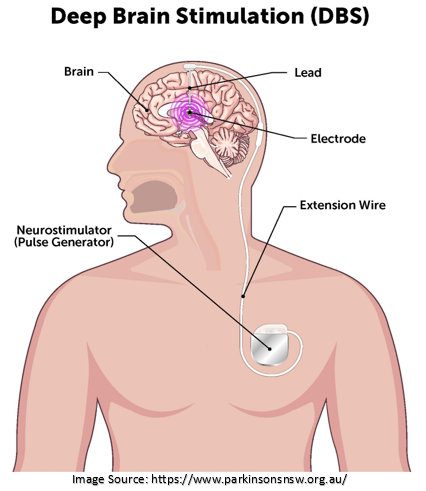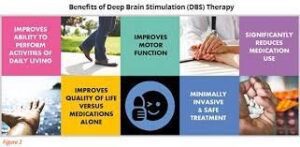For individuals with movement disorders, including Parkinson’s, essential tremor, or dystonia, deep brain stimulation (DBS) surgery can change their lives, but this transformation takes time. According to Dr. Gurneet Singh Sawhney, one of the leading neurosurgeon in India, DBS surgery can help manage tremors, slow movement, and other Parkinson’s or movement disorder symptoms by electrically stimulating specific symptoms areas of the brain with electrodes.
It can take months to almost a year to modify the gadget settings to meet a patient’s particular needs after the procedure. Every patient has a unique and highly personalized rehabilitation process.
In this article, we will discuss DBS surgery, who needs it, what to expect after the procedure, the recovery process, and more.
First, let’s have a short,
Overview of Deep Brain Stimulation (DBS)

During deep brain stimulation, a mild electrical current is administered to a particular region of your brain. Several conditions can be managed by the current’s electricity, which activates the brain cells.
The current travels to your brain through one or more wires connected to a small implanted device placed beneath your skin close to your collarbone.
What can I expect after DBS surgery?
- Your doctor may arrange a follow-up appointment within a few weeks of the pulse generator implantation surgery. They can begin setting up the pulse generator at this time.
- The latest pulse generators are equipped with an integrated wireless antenna. This makes it possible for doctors to access and modify the device from outside of your body.
- It may take some time and repeated visits for changes to get the pulse generator’s ideal settings.
- The majority of pulse generators have long-lasting, unique batteries. These gadgets’ standard batteries have a three- to five-year lifespan. Rechargeable batteries, used in some devices, have a nine-year lifespan.
Although the procedure to replace the battery also requires surgery, it usually takes less time and is less involved than the surgery to implant the pulse generator.
Who needs DBS surgery?
DBS surgery can treat conditions that impact the performance and function of neurons—a crucial variety of brain cells. The talents that those neurons regulate are affected when they aren’t functioning properly. Depending on the severity of the ailment, they may lose any or all of those skills.
What are the Benefits of DBS Surgery?
DBS offers several benefits. These consist of the following:
- If medication is ineffective, DBS may provide an alternative treatment:
Dr. Gurneet Singh Sawhney often recommends DBS surgery in Mumbai when drugs are ineffective or no longer effective. Since Parkinson’s disease treatments gradually lose efficacy over time, the doctor may increase your dosage. This may cause other side effects.
Your symptoms are under control with fewer side effects thanks to DBS, which usually makes lower drug dosages effective once again.
- DBS can be a lifesaver and changer:
Certain medical disorders that DBS treats can have severe side effects that prevent you from performing even the most basic tasks. DBS can treat your illness and alleviate your symptoms, enhancing your quality of life.
DBS can relieve and lower seizure frequency for disorders like medication-resistant epilepsy, where surgical resection is not an option.
- It can be adjusted:
Your healthcare professional can adjust the pulse generator parameters to see what works best for you.
- It can be reversed:
If DBS doesn’t work or has adverse effects you can’t handle, a follow-up surgery can be used to remove the leads and pulse generator.
How long does recovery take?
- When you notice changes in your symptoms or how you feel, your doctor is the best person to advise you on how long your recovery may take.
- They can estimate the time it will take you to recover. But this period may vary based on your situation, other medical illnesses you may have, and your general health.
- According to Dr. Gurneet Singh Sawhney, one of the best neurosurgeon in Mumbai, most patients require one day of hospitalization following the procedure to implant the DBS leads in their brains. Usually, you can return home the same day after surgery to implant the pulse generator.
In general, the recovery process requires several weeks. Most likely, your doctor will instruct you to:
- After DBS surgery, you should take a two-week break from all activities:
This encompasses even minor activities, like sexual activity or housework. Lifting anything heavier than 5 pounds (2.25 kilograms) is not advised.
- For at least four to six weeks, refrain from moderate to vigorous exercises:
This covers both physical activity and labor. After this, most people can resume their regular activities.
- Be careful when stretching or moving:
Following surgery to implant the pulse generator, you should refrain from making specific movements for a few days, such as raising your hands above your head. Your doctor will advise you on how long you must limit your activities.
Deep brain stimulation (DBS) is a treatment that can treat various illnesses that impact the brain and mental health. It is nearly always a possibility after trying other remedies and techniques without success.
Although it is most frequently used to treat Parkinson’s and epilepsy, researchers are also looking at the possibility of using it to treat other ailments.
Even though it requires two to three procedures, it is also quite effective at treating illnesses that negatively impact your quality of life and reducing symptoms

